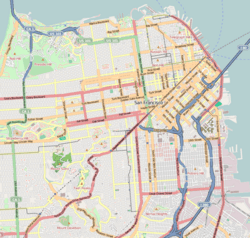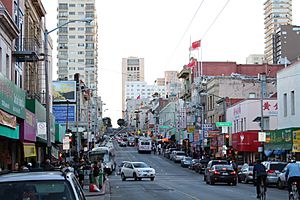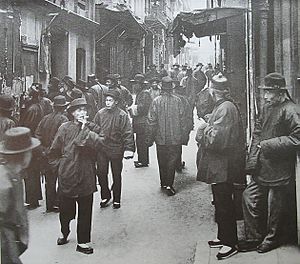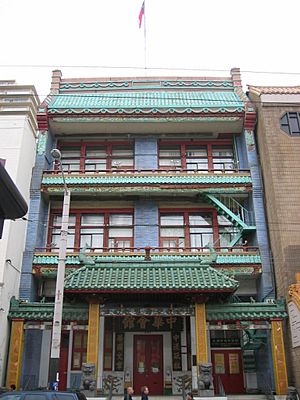Chinatown, San Francisco facts for kids
Quick facts for kids
Chinatown
|
|
|---|---|
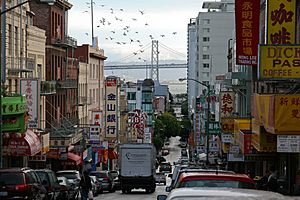
Chinatown businesses line Jackson Street, with the Bay Bridge in the background.
|
|
| Country | |
| State | |
| City-county | |
| Population
(2000)
|
|
| • Total | 34,891 |
| • Estimate
(2013)
|
34,557 |
| Time zone | UTC−8 (Pacific) |
| • Summer (DST) | UTC−7 (PDT) |
| ZIP Codes |
94108, 94133, 94102, 94111, 94109
|
| Area Codes | 415/628 |
Chinatown in San Francisco, California, is the oldest Chinatown in North America. It started in 1848 on Grant Avenue and Stockton Street. This neighborhood is very important to the history and culture of Chinese immigrants in North America.
Chinatown has kept its special customs, languages, places of worship, social clubs, and unique identity. It has hospitals, parks, churches, a post office, and many other buildings. San Francisco's Chinatown is also a very popular tourist attraction. More people visit Chinatown each year than the famous Golden Gate Bridge.
Contents
Where is Chinatown Located?

San Francisco's Chinatown is located near the neighborhoods of North Beach and Telegraph Hill. The area is about half a mile long and a quarter mile wide. It covers 24 city blocks and has two postal ZIP codes (94108 and 94133).
Two main streets run through Chinatown: Grant Avenue (都板街) and Stockton Street (市德頓街). Grant Avenue is famous for its Dragon Gate and St. Mary's Square. This square has a statue of Dr. Sun Yat-Sen and a memorial for Chinese war veterans. Grant Avenue is full of shops, restaurants, and mini-malls that attract many tourists.
Stockton Street is less visited by tourists. It feels more like traditional Hong Kong, with its fresh produce and fish markets. Buildings here are usually three or four stories tall. Shops are on the bottom floor, and homes are above them.
Portsmouth Square is a busy open space in Chinatown. It sits above a large underground parking lot.
Who Lives in Chinatown?
Chinatown is a very crowded place. The San Francisco Planning Department says it is "the most densely populated urban area west of Manhattan." About 15,000 people live in just 20 city blocks.
Most people in Chinatown speak Chinese dialects, mainly Cantonese and some Mandarin. The average income in Chinatown is lower than in other parts of San Francisco.
How the Population Changed
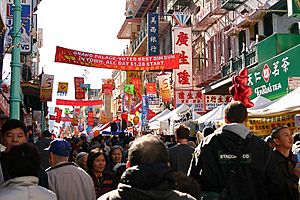
Many immigrants from Hong Kong started coming to San Francisco in the late 1960s. They often had to take jobs that didn't pay much because they didn't speak much English. Because of the crowded conditions and poverty, other Chinese neighborhoods have grown in San Francisco. Many Chinese people from Southeast Asia have moved to these outer neighborhoods. They often travel to Chinatown to do their shopping.
A Look at Chinatown's Past
San Francisco's Chinatown was the main place where many Chinese immigrants arrived in the United States. From the 1850s to the early 1900s, many Chinese people came to the country through this area. Most Chinese shopkeepers, restaurant owners, and workers in Chinatown were men. Many Chinese men also found jobs working for big companies like Central Pacific. These men helped build the Transcontinental Railroad across the country.
In 1882, the United States Government passed the Chinese Exclusion Act. This was a law that made it very hard for Chinese people to come to the country. It was the first time an immigration law was made to stop people from a single ethnic group from entering the US. This law was ended during World War II by the Magnuson Act.
In March 1900, a man in Chinatown became sick with a serious illness. The area was closed off, and health officials worked to clean buildings and streets. After protests, the closure was lifted. The illness lasted four years and affected many people in Chinatown.
In 1906, a big earthquake destroyed most of San Francisco, including Chinatown. The famous Sam Wo restaurant opened in 1912. By 1915, Chinatown was mostly rebuilt and busy again.
After World War II, a law called the War Brides Act allowed Chinese-American soldiers to bring their families to the US. This caused a big increase in Chinatown's population during the 1950s.
In the 1960s, Chinatown changed again. More immigrants arrived, and many stores moved from Grant Avenue to Stockton Street. Stockton Street had cheaper rents and better transportation because of the Muni trolleybus line.
Chinatown's Culture
Important Organizations
San Francisco's Chinatown is home to the Chinese Consolidated Benevolent Association. This group is also known as the Chinese Six Companies. It was created to help Chinese people move to and travel within the United States. It also spoke up for them across the country.
The Chinese Culture Center is a non-profit group that helps the community. It is located on the third floor of a Holiday Inn. The Center has exhibits about Chinese life in the United States. It also organizes tours of the Chinatown area.
Fun Events
The San Francisco Chinese New Year Festival and Parade started in the 1950s. It includes art shows, street dances, martial arts displays, music, and a fashion show.
The Autumn Moon Festival celebrates the changing seasons. It's a time to give thanks for a good summer harvest. This festival happens every year in mid-September and is free for everyone to enjoy.
Traditional Chinese funeral processions are also held in Chinatown. A marching band plays music, and a car follows, showing a picture of the person who has passed away.
Chinatown's Fame
Chinatown's restaurants are known as the birthplace of Westernized Chinese food. Dishes like Chop Suey and Dim Sum were first introduced to Americans here.
Chinatown has been the setting for many movies, TV shows, plays, and documentaries. Some famous ones include The Maltese Falcon, Big Trouble in Little China, The Pursuit of Happyness, and Godzilla.
Chinese-American writers like Russell Leong and Amy Tan grew up in Chinatown. Amy Tan's experiences in the neighborhood inspired her famous book The Joy Luck Club and the movie made from it.
Basketball player Willie "Woo Woo" Wong grew up in Chinatown in the 1940s. A local playground is named after him.
Actor Bruce Lee was born at San Francisco Chinese Hospital in Chinatown. He moved to Hong Kong when he was three months old. When he was eighteen, he returned to the United States and lived in San Francisco's Chinatown for a few months before moving to Seattle.
Getting Around Chinatown
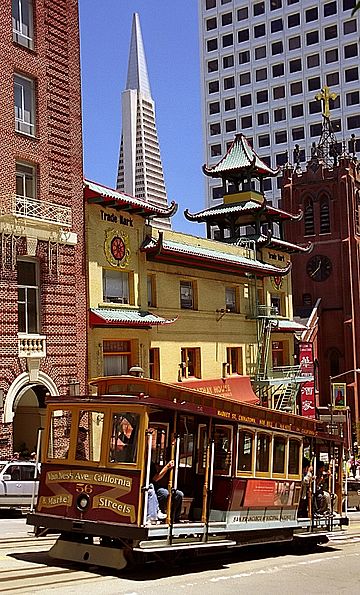
San Francisco cable cars have served parts of Chinatown for a long time. Today, the cable car system serves the southern part (along California Street) and the western part (along Powell Street) of the neighborhood.
The Stockton Street Tunnel was finished in 1914. It brought streetcar service to Stockton Street. Later, buses replaced the streetcars along this route.
The Broadway Tunnel was completed in 1952. It connects Chinatown with Russian Hill and Van Ness Avenue to the west.
The 49-Mile Scenic Drive is a special route that goes through Chinatown. It highlights the corner of Grant and Clay streets.
Cool Facts About Chinatown, San Francisco
- Chinese tradition says that firecrackers were used to scare away bad spirits. Since real firecrackers are not allowed in Chinatown, stores sell "Pop Pop" boxes. These have small packages that make a popping sound when thrown on the floor.
- Tourists can watch fortune cookies being made at the Golden Gate Fortune Cookie Factory.
- Many herbal pharmacies in Chinatown teach about and sell herbal medicines.
- Old St. Mary’s Cathedral was built in 1854. It is the oldest Catholic cathedral in California.
- All the bricks for Old St. Mary’s Cathedral were brought in from China.
- The first Chinese people to arrive in San Francisco were one man and two women in 1848.
- The only photos known to have survived from before the 1906 earthquake were taken by Arnold Genthe.
Images for kids
-
Sacramento St.; 唐人街: literally "Tang people street"
-
Officers of the Chinese Six Companies
-
The headquarters of the Chinese Six Companies on Stockton Street.
See also
 In Spanish: Chinatown (San Francisco) para niños
In Spanish: Chinatown (San Francisco) para niños


